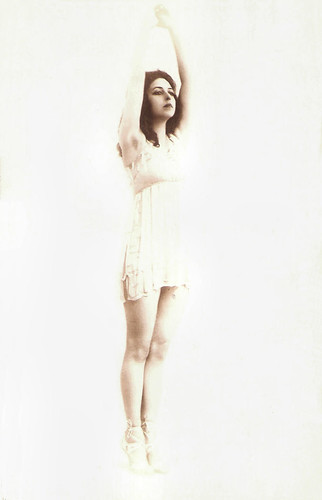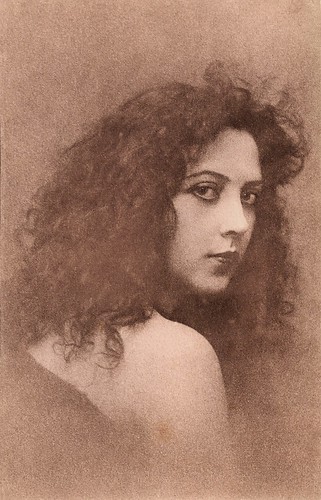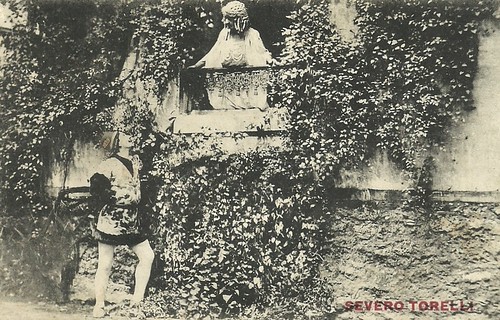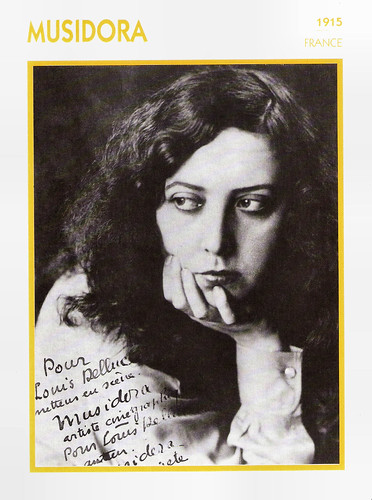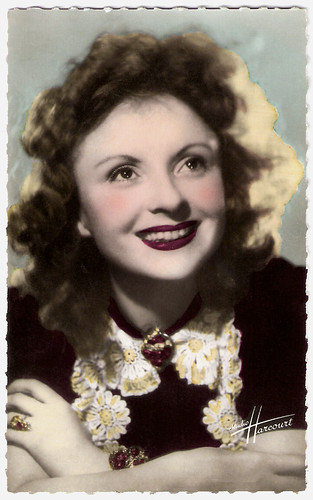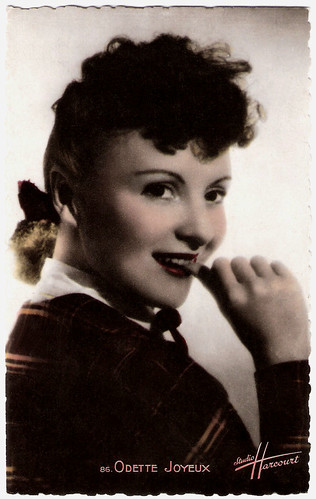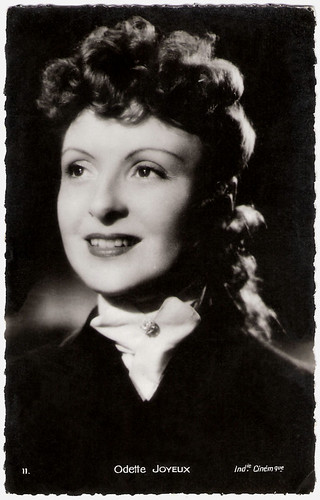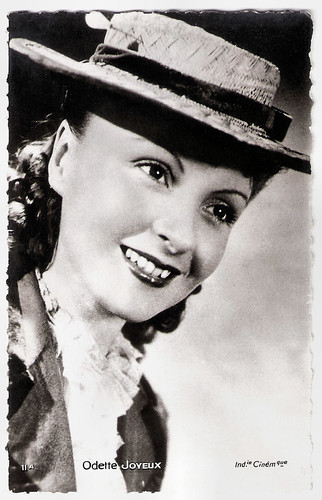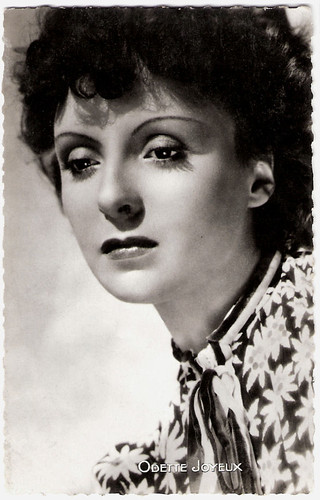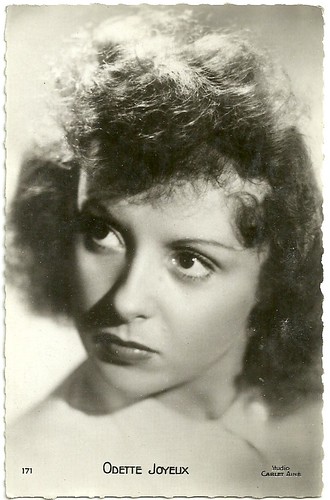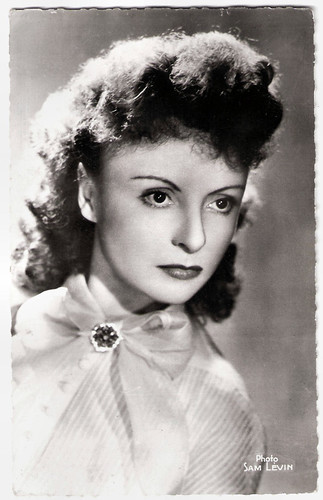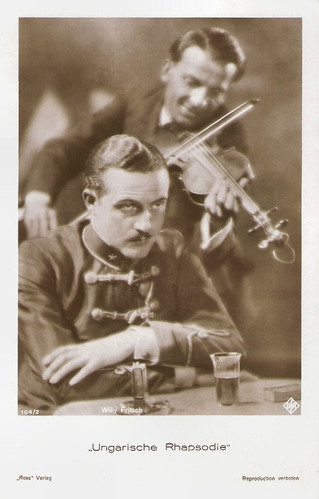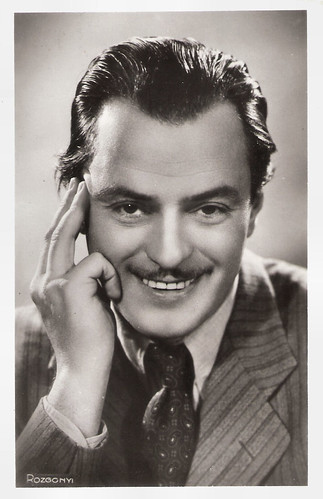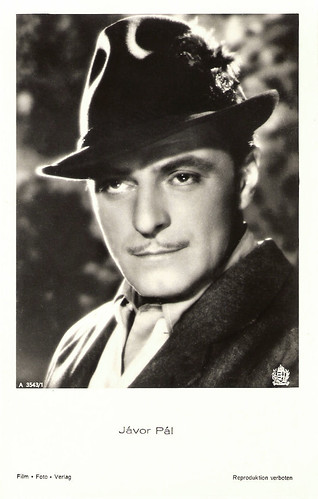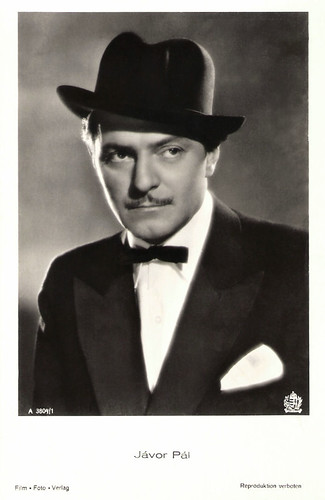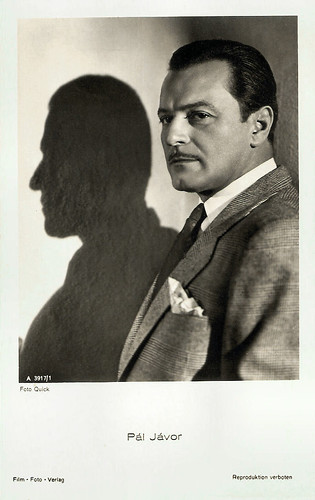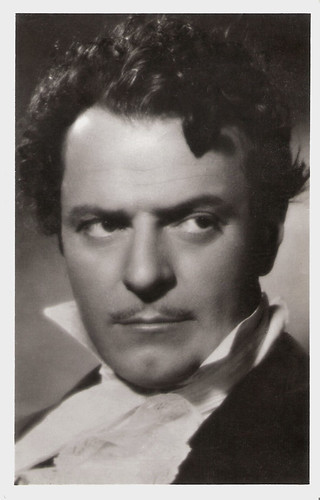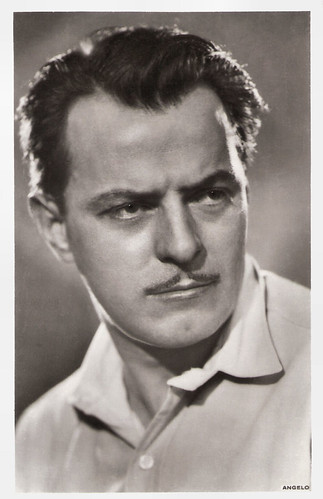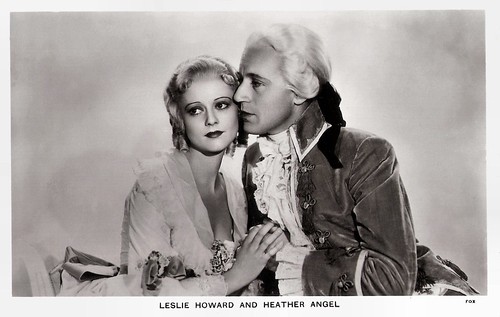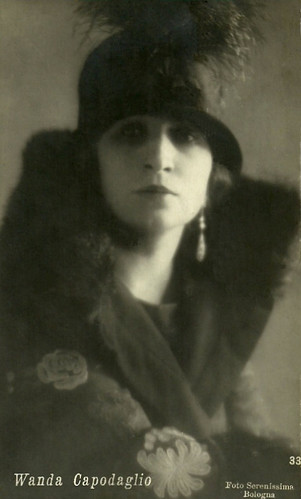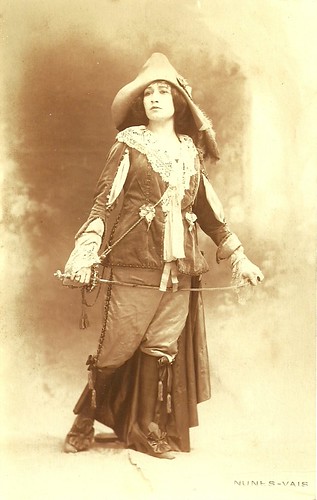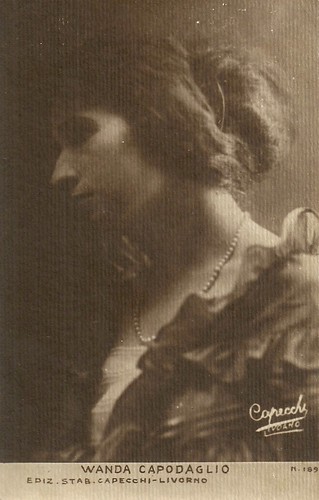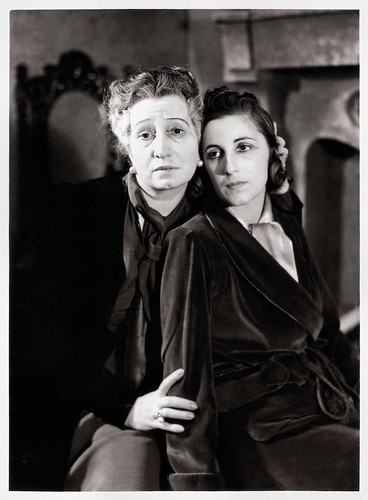During the 1950s and 1960s, American singer and actress Olive Moorefield (1932) worked in Austria and West Germany. She starred on stage in musicals and operas, acted in several films, including Monpti (1957) with Romy Schneider and Horst Buchholz, and Onkel Toms Hütte/Uncle Tom’s Cabin (1964), and she appeared in television shows.
![Olive Moorefield in Monpti (1957)]()
German postcard by Ufa. Photo: Vogelmann / NDF / Herzog-film. Publicity still for Monpti (Helmut Käutner, 1957).
![Olive Moorefield in Die Beine von Dolores (1957)]()
German postcard by Kunst und Bild, Berlin-Charlottenburg, no. V 172. Photo: Kurt-Ulrich-Film / Constantin / Wesel. Publicity still for Die Beine von Dolores/The legs of Dolores (Géza von Cziffra, 1957).
Olive Moorefield was born in 1932, in Pittsburgh, Pennsylvania, USA. She had seven siblings. After attending the Pennsylvania College, she took singing and acting lessons. In October 1952 she debuted on Broadway in New York in the play My Darlin 'Aida.
Moorefield went on extensive European tour and settled down in 1953 in Vienna, Austria. There she received a commitment at the Vienna Volksoper. At the time, this was very unusual in Europe for a black artist. She celebrated her first success with the Cole Porter musical Kiss Me Kate. Initially, she played the supporting role of Bianca, but later also the leading role of the Kate. Many other productions would follow in the next two decades and Moorefield became very popular among Viennese audiences.
Soon also parts in films followed. Moorefield first appeared as a singer in such Austrian films as the drama Das Licht der Liebe/The Light of Love (Robert A. Stemmle, 1954) with Paula Wessely, the comedy Liebe, die den Kopf verliert/Love that loses its head (Thomas Engel, 1956) starringPaul Hubschmid and the musical Scherben bringen Glück/Seven Years Hard Luck (Ernst Marischka, 1957) with Adrian Hoven.
She made several records and did not shy away from pop music. In Germany, she also appeared again as a singer in light entertainment as Einmal eine grosse Dame sein/To be a great lady for once (Erik Ode, 1957) and Die Beine von Dolores/The legs of Dolores (Géza von Cziffra, 1957).
Her first bigger part was in the melancholic romantic comedy-drama Monpti/Love from Paris (Helmut Käutner, 1957), starring Romy Schneider and Horst Bucholz, then Germany's biggest stars, as the young lovers. She also had a supporting part in Der schwarze Blitz/The black flash (Hans Grimm, 1958), featuring ski champion Toni Sailer.
![Olive Moorefield]()
German postcard by Kunst und Bild, Berlin-Charlottenburg, no. T 875. Photo: Kurt-Ulrich-Film / Constantin / Wesel. Publicity still for Die Beine von Dolores/The legs of Dolores (Géza von Cziffra, 1957).
![Olive Moorefield in Die Beine von Dolores (1957)]()
German postcard by Kunst und Bild, Berlin-Charlottenburg, no. V 181. Photo: Kurt-Ulrich-Film / Wesel. Publicity still for Die Beine von Dolores/The legs of Dolores (Géza von Cziffra, 1957).
![Olive Moorefield]()
German postcard by Kolibri-Verlag G.m.b.H., Minden/Westf., no. 2644. Photo: CCC / Deutsche Film Hansa (DFH) / Arthur Grimm. Publicity still for Einmal eine grosse Dame sein/To be a great lady for once (Erik Ode, 1957).
![Olive Moorefield in Einmal eine grosse Dame sein (1957)]()
German postcard by Kunst und Bild, Berlin-Charlottenburg, no. I 254. Photo: Grimm / CCC / Deutsche Film Hansa. Publicity still for Einmal eine grosse Dame sein/Once a great lady (Erik Ode, 1957).
Olive Moorefield had her first leading role in the cinema in the Austrian comedy Skandal um Dodo/Scandal around Dodo (Eduard von Borsody, 1959) opposite Harald Juhnke. After that she returned to guest parts as a singer in Riviera-Story/Riviera Story (Wolfgang Becker, 1961) with Ulla Jacobsson, and Straße der Verheißung/Street of Temptation (Imo Moszkowicz, 1962) starring Mario Adorf.
She had another another leading role in Onkel Toms Hütte/Uncle Tom's Cabin (Géza von Radványi, 1965). The film is based on Harriet Beecher Stowe's classic novel of the same name. In the pre-Civil War South, a sadistic plantation-owner (Herbert Lom) brutalises his slaves to the point of them having no other choice but to rebel. Always obedient, peaceful and honest old slave Tom (John Kitzmiller) plays a central role in this tragedy. Moorefield played the slave Cassy.
Jugu Abraham atIMDb: "While the film is true to Harriet Beecher Stowe's story, the director's implicit comparison of the past and present America (skyscraper skyline shown during the credits) is interesting. Eartha Kitt's song at the end is unforgettable. The film is distinctly European (the director is Hungarian) in style and the story and songs could merit a re-release." Actually, there was a curious American re-release in 1976,Uncle Tom's Cabin (Al Adamson, 1976), edited from the 1965 film but with new scenes added. It was promoted with the tagline 'Before Mandingo and Drum there was Uncle Tom's Cabin'.
In the following decade, Moorefield did not return to the cinema, but she kept appearing in the German-speaking theatre and on TV. She was Bess in the Vienna production of George Gershwin's Porgy and Bess, which was also televised. I
n 1969 Olive Moorefield married Dr. Kurt Mach, with whom she has a son, Oliver Mach. She gradually withdrew from the limelight into private life. In later years, her name (now Olive Moorefield-Mach) reappeared on the administrative side at music festivals.
Olive Moorefield sings Bongo Rock in Das alte Försterhaus (1956). Source: fritz51203 (YouTube).
Olive Moorefield sings Etwas leise Musik in Der schwarze Blitz/The black flash (1958) with Oliver Grimm. Source: fritz51203 (YouTube).
Sources: Wikipedia (German) and IMDb.

German postcard by Ufa. Photo: Vogelmann / NDF / Herzog-film. Publicity still for Monpti (Helmut Käutner, 1957).

German postcard by Kunst und Bild, Berlin-Charlottenburg, no. V 172. Photo: Kurt-Ulrich-Film / Constantin / Wesel. Publicity still for Die Beine von Dolores/The legs of Dolores (Géza von Cziffra, 1957).
Very unusual
Olive Moorefield was born in 1932, in Pittsburgh, Pennsylvania, USA. She had seven siblings. After attending the Pennsylvania College, she took singing and acting lessons. In October 1952 she debuted on Broadway in New York in the play My Darlin 'Aida.
Moorefield went on extensive European tour and settled down in 1953 in Vienna, Austria. There she received a commitment at the Vienna Volksoper. At the time, this was very unusual in Europe for a black artist. She celebrated her first success with the Cole Porter musical Kiss Me Kate. Initially, she played the supporting role of Bianca, but later also the leading role of the Kate. Many other productions would follow in the next two decades and Moorefield became very popular among Viennese audiences.
Soon also parts in films followed. Moorefield first appeared as a singer in such Austrian films as the drama Das Licht der Liebe/The Light of Love (Robert A. Stemmle, 1954) with Paula Wessely, the comedy Liebe, die den Kopf verliert/Love that loses its head (Thomas Engel, 1956) starringPaul Hubschmid and the musical Scherben bringen Glück/Seven Years Hard Luck (Ernst Marischka, 1957) with Adrian Hoven.
She made several records and did not shy away from pop music. In Germany, she also appeared again as a singer in light entertainment as Einmal eine grosse Dame sein/To be a great lady for once (Erik Ode, 1957) and Die Beine von Dolores/The legs of Dolores (Géza von Cziffra, 1957).
Her first bigger part was in the melancholic romantic comedy-drama Monpti/Love from Paris (Helmut Käutner, 1957), starring Romy Schneider and Horst Bucholz, then Germany's biggest stars, as the young lovers. She also had a supporting part in Der schwarze Blitz/The black flash (Hans Grimm, 1958), featuring ski champion Toni Sailer.

German postcard by Kunst und Bild, Berlin-Charlottenburg, no. T 875. Photo: Kurt-Ulrich-Film / Constantin / Wesel. Publicity still for Die Beine von Dolores/The legs of Dolores (Géza von Cziffra, 1957).

German postcard by Kunst und Bild, Berlin-Charlottenburg, no. V 181. Photo: Kurt-Ulrich-Film / Wesel. Publicity still for Die Beine von Dolores/The legs of Dolores (Géza von Cziffra, 1957).

German postcard by Kolibri-Verlag G.m.b.H., Minden/Westf., no. 2644. Photo: CCC / Deutsche Film Hansa (DFH) / Arthur Grimm. Publicity still for Einmal eine grosse Dame sein/To be a great lady for once (Erik Ode, 1957).

German postcard by Kunst und Bild, Berlin-Charlottenburg, no. I 254. Photo: Grimm / CCC / Deutsche Film Hansa. Publicity still for Einmal eine grosse Dame sein/Once a great lady (Erik Ode, 1957).
Before Mandingo and Drum there was Uncle Tom's Cabin
Olive Moorefield had her first leading role in the cinema in the Austrian comedy Skandal um Dodo/Scandal around Dodo (Eduard von Borsody, 1959) opposite Harald Juhnke. After that she returned to guest parts as a singer in Riviera-Story/Riviera Story (Wolfgang Becker, 1961) with Ulla Jacobsson, and Straße der Verheißung/Street of Temptation (Imo Moszkowicz, 1962) starring Mario Adorf.
She had another another leading role in Onkel Toms Hütte/Uncle Tom's Cabin (Géza von Radványi, 1965). The film is based on Harriet Beecher Stowe's classic novel of the same name. In the pre-Civil War South, a sadistic plantation-owner (Herbert Lom) brutalises his slaves to the point of them having no other choice but to rebel. Always obedient, peaceful and honest old slave Tom (John Kitzmiller) plays a central role in this tragedy. Moorefield played the slave Cassy.
Jugu Abraham atIMDb: "While the film is true to Harriet Beecher Stowe's story, the director's implicit comparison of the past and present America (skyscraper skyline shown during the credits) is interesting. Eartha Kitt's song at the end is unforgettable. The film is distinctly European (the director is Hungarian) in style and the story and songs could merit a re-release." Actually, there was a curious American re-release in 1976,Uncle Tom's Cabin (Al Adamson, 1976), edited from the 1965 film but with new scenes added. It was promoted with the tagline 'Before Mandingo and Drum there was Uncle Tom's Cabin'.
In the following decade, Moorefield did not return to the cinema, but she kept appearing in the German-speaking theatre and on TV. She was Bess in the Vienna production of George Gershwin's Porgy and Bess, which was also televised. I
n 1969 Olive Moorefield married Dr. Kurt Mach, with whom she has a son, Oliver Mach. She gradually withdrew from the limelight into private life. In later years, her name (now Olive Moorefield-Mach) reappeared on the administrative side at music festivals.
Olive Moorefield sings Bongo Rock in Das alte Försterhaus (1956). Source: fritz51203 (YouTube).
Olive Moorefield sings Etwas leise Musik in Der schwarze Blitz/The black flash (1958) with Oliver Grimm. Source: fritz51203 (YouTube).
Sources: Wikipedia (German) and IMDb.

































